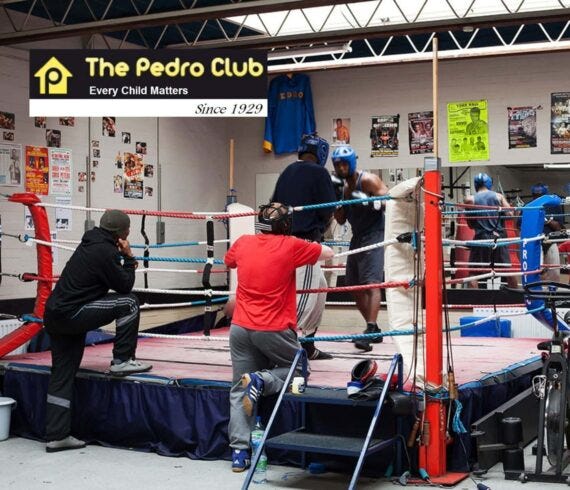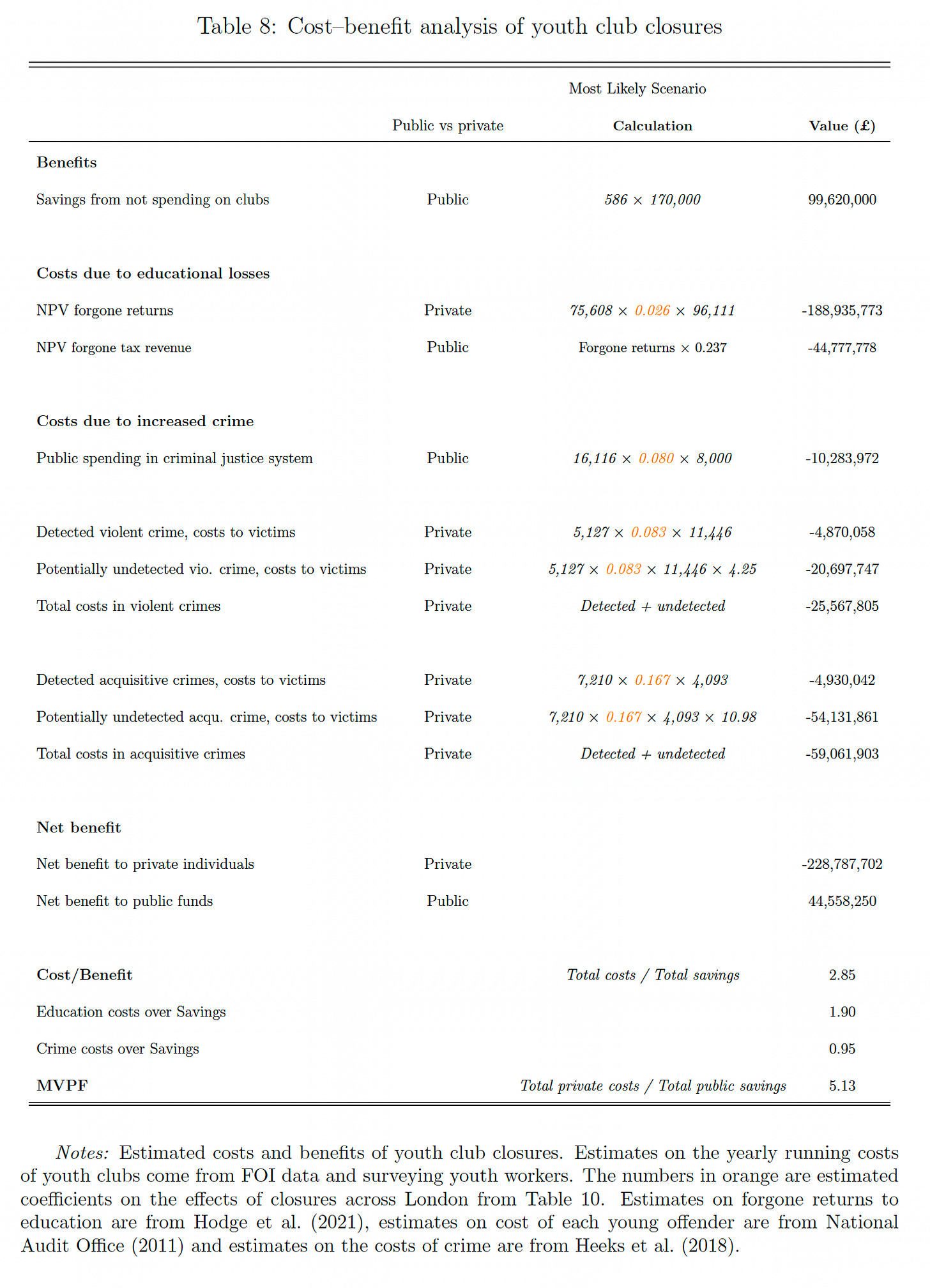Did Austerity Scar Young Men?
Shoplifting has soared to its highest level in 20 years in England and Wales. Violent crime has likewise become a major concern in America.
Two new economics papers shed valuable light on crime prevention through an unexpected window - Britain’s devastating austerity. Between 2010-2019, budget cuts led to widespread closures of both youth centers and police stations, creating two distinct natural experiments.
Carmen Villa documents how closing youth clubs triggered a surge in teenage crime. Elisa Facchetti reveals how shuttering London's police stations led to spikes in violent crime. Together, their findings demonstrate that safer communities depend on both prevention and deterrence. They also expose the toll of austerity, shunting disadvantaged young men onto dangerous paths.
Austerity Cuts to Youth Clubs
Youth clubs are community spaces in which young people can hang out with friends, play ping pong or pool, quietly study, or talk to trained youth workers. Sounds fun! Back in 2009, these clubs regularly attracted 40% of London teens. As one boy shared,
“I come twice a week. My dream is playing football. Sometimes, it’s hard at home and when I come here you’re free from whatever is going on. When I play, I clear out my head.”
But then came austerity, and disadvantaged young men were thrown under the bus. Between 2010 and 2019, UK government spending on youth services plummeted from £1.4 billion to under £400 million. In London, youth service budgets fell by 71%. Nearly one-third of the capital’s youth clubs permanently closed their doors. Those that survived faced reduced hours, staff cuts, and scaled-back programming.
These closures were quasi-random: staggered over time, not concentrated in areas of prior disadvantage (e.g. with high social housing), nor did they occur differently in areas affected by other austerity cuts.
Since local authorities faced direct budget cuts, council-run clubs were much more likely to close than charity-operated facilities. This created geographical disparities in access, with some neighbourhoods losing all their youth provision while others maintained services.
How did this impact teenagers’ lives?
Carmen Villa’s Job Market Paper
Using Freedom of Information requests, Villa constructed a novel database tracking the location and timing of youth club closures across London. She combined multiple administrative datasets:
Police records capturing all recorded crimes in London, including details on detected offences
Educational records showing student exam performance
Survey data on young people’s time use
Population statistics to calculate offending rates
Employing difference-in-differences methods, Villa compared areas where youth clubs closed to similar areas where clubs remained open. She provides the first causal evidence of the devastating impact of these closures:
Crime
Closures led to HUGE increases in youth offending - at the granular block level. The proportion of youth offenders increased by 2 per thousand per block per year. That is a 14% increase over the mean.
Rises across drug offences, violent crime and theft
Younger teens suffered most.
Educational Impact:
The closure of youth clubs led to a 4% standard deviations decline in GCSE exam performance overall, with a 12% standard deviations drop for students from low-income backgrounds (Table 2).
Students who lost access at younger ages were most negatively affected.
Negative effects were not mitigated by proximity to alternative facilities like libraries or sports centres.
Less Study, More Screentime
After closures, affected youth significantly changed their daily activities:
55% decrease in ability to concentrate
Significant increases in screen time (social media, video games, TV).
Caveat: this is a survey of 1,132 individuals, but only 190 of whom were near youth club closures.
Fiscal implications
While closures aimed to save money, Villa finds this was short-sighted. Every £1 saved actually resulted in losses of £2.85:
Increased criminal justice system costs
Higher victim costs from crime
Reduced lifetime earnings from poorer educational outcomes
Youth Clubs!
Young men - or at least the least educated - are falling behind, struggling to progress to college. Without college, they get stuck in sectors at risk of automation.
Boosting educational progress is absolutely vital. But how?
While biology dictates that male pubescent bodies will surge with testosterone, society can create infrastructure that channels this productively. But this requires fiscal space and political prioritisation.
Carmen Villa brilliantly demonstrates that state-funded clubs aren’t just a bit of fun, they can radically alter young men’s lives and create safer communities. Austerity-induced closures shut down disadvantaged young men’s pathway to better jobs, while burdening the rest of society with higher crime.
Since Villa has linked data on all those affected, I suspect she will write another paper on how youth-club closures radically altered entire life trajectories.

Elisa Facchetti’s Study on Policing
But prevention is only part of the story. Community safety also hinges on effective policing. Yet under austerity, 70% of London’s police stations were closed between 2010 and 2016. The consequences were literally fatal.
By carefully controlling for other cuts (including to youth services), Elisa Facchetti isolates the specific impact of reduced police infrastructure. Her findings are stark:
Violent crime increased by 11% in areas that lost their local police station
Effects were concentrated in crime hot spots and areas nearest closed police stations (Figures 7 and 8)
Clearance rate for crimes fell by 3.7%
House prices declined, particularly in high-crime areas.
Lessons for Community Safety
Together, Carmen Villa and Elisa Facchetti’s research suggests that public safety requires sustained investment in both prevention and policing. Youth clubs help channel young energy productively, while effective policing provides a powerful deterrent. Cutting either creates gaps the other cannot fill.
Austerity degraded both pillars simultaneously, hurting the most disadvantaged neighbourhoods.
“Good on Paper” Podcast
For more on crime and policing, check out Jerusalem Demsas’s fantastic podcast with Jennifer Doleac, as well as Doleac’s essay in the New York Times.

















These are brilliant studies and in a different world might actually have some impact. Tragically however, the powers that be will not be moved. They don't care about the effects of their austerity measures. In fact, this is the outcome they desire in that it makes them richer and widens the gap between them and the unworthy. These outcomes are by design. So astute, data based research which documents these outcomes will not move them - they may actually welcome confirmation of their success.
Shoplifting in America is a problem with non-enforcement of crimes in several major US metros. In particular, Proposition 47 effectively legalized theft as long as it was less than $950. Thieves were walking into stores with calculators to make sure they were below the threshold.